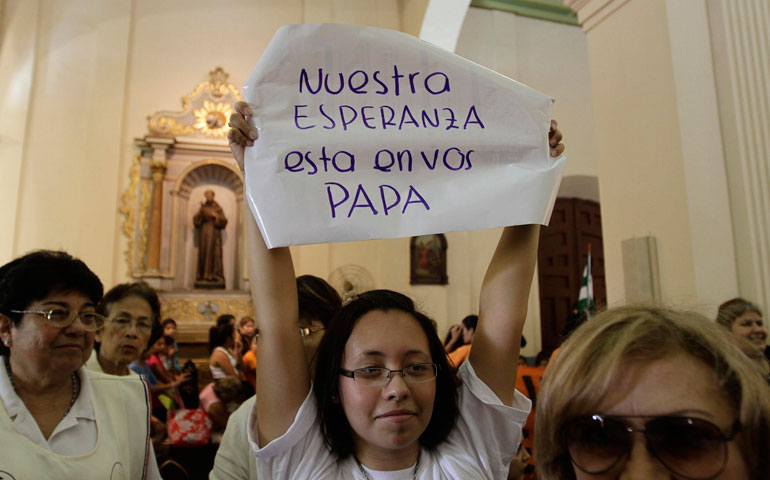
A woman holds a sign that reads: “Our hope is in you, pope,” during a Mass of thanksgiving in honor of Pope Francis at the Metropolitan Cathedral in Asuncion, Paraguay, March 17. (CNS/Reuters/Jorge Adorno)
As the cardinals pack their bags and catch their planes home, Pope Francis is left with the unfinished work of reforming the Vatican Curia, something practically all of the cardinals said they wanted. But it is not clear what they mean by "reform." "Reform" is, after all, in the eye of the beholder.
I would distinguish between two types of reform: better management and comprehensive reform.
Much of the scandals surrounding the Curia recently are simple management problems that can be dealt with following "best practices" of business and government.
Financial corruption: Governments and corporations have been dealing with financial corruption for centuries. The solutions involve proper accounting systems, rules about conflict of interest, competitive bidding, transparency in finances, and internal and external auditors. Part of the problem here is that the leadership team (cardinals, bishops and priests) have no understanding and training in these fields. They have to depend on others. But the problem also results from the arrogance of thinking that the church is somehow different and cannot learn from government and business practices.
Some actions have been taken. Pope John Paul II brought in Cardinal Edmund Szoka to modernize the Vatican accounting system. Pope Benedict XVI took a huge step in 2011 by insisting that the Vatican follow the standards set by the European agency Moneyval. He wanted the Vatican on Moneyval's "white list" of good countries. In the past, the Vatican always argued that it was unique and could not be judged by anyone else's standards. Benedict's decision means that every year outsiders will check up on what the Vatican is doing and give a public report.
It is in the Vatican City State and the Vatican Bank where financial reform makes most sense. These entities do secular things (museum, building repair, stores, etc.) for which best practices are easily available. The Congregation for the Evangelization of Peoples also has lots of money that is to be used for the missions. This agency should follow the best standards of international nongovernmental organizations.
Sexual impropriety: Sexual impropriety occurs not just in the Catholic church, it also occurs in governments, businesses and the military. That is why there are rules against sexual harassment, sex between employees and supervisors, and advancement in exchange for sexual favors. Nor are rules enough. There have to be compliance officers investigating allegations and enforcing the rules. If these offenses are job-related, the Vatican should treat them as causes for termination and not simply as sins.
Petty infighting: It is useful for an executive to have subordinates who argue with each other so that he gets a variety of advice. Frankly, one of the problems of the papacies of John Paul and Benedict was their unwillingness to listen to a variety of voices. But when the fighting is over power and prestige, it becomes dysfunctional and a strong hand is needed to get people back in line. Archbishop Giovanni Benelli as sostituto played this role in the papacy of Paul VI, similar to that of the White House chief of staff. Cardinals trembled in his presence. He kept people on message.
Leaking of documents: Every government has this problem and most fail to stop it or to catch the leakers. People leak information for four reasons: for money; because they are being blackmailed; because they want to embarrass someone; or because they want to force a change in policy.
Part of the solution is to classify fewer documents as secret. But if you are going to have an investigation, then it needs to be professional. The Vatican prosecutors and judges accepted the butler's explanation for why he stole and leaked documents -- he wanted to reform the church and he acted alone. Did anyone check his financial records or his phone records? And in the end, he only got a slap on the wrist.
The Italian press is filled with stories about curial officials being blackmailed for sexual improprieties. Could this be a cause of leaks? Are Italian journalists blackmailing their sources?
What about the secret report on the investigation done by the three cardinals appointed by Benedict? Do you really think that three cardinals over the age of 80 have the skills of Columbo, Nancy Drew and Miss Marple? My guess is that their report is simply filled with what is already publicly known plus hearsay and opinion, which would make it an embarrassment to publish.
Comprehensive reform
Speaking about reforming the Curia is like speaking about reforming the U.S. tax code. Everyone is for it until it affects them.
Even members of the Roman Curia speak about the need for reform, but for a curial cardinal, reform means he gets more power and his opponent in another office gets less. For conservatives, reform means having a stronger Curia that speaks with one voice in imposing the Vatican's vision on the rest of the church. For moderates, reform means a decentralization of power and more collegiality. In other words, you cannot reform the Curia until you know what you want it to do.
For example, many people talk about making the Curia more efficient. Frankly, I am in favor of the Congregation for Doctrine of the Faith being more efficient in dealing with abusive priests, but the last thing I want is an efficient inquisition investigating theologians.
My own prescription for reforming the Curia is based on the supposition that it should be in service to the pope as head of the college of bishops. It should be organized as a civil service and not part of the hierarchy of the church.
Thus my reforms start with not making members of the Curia bishops or cardinals. The current Curia is organized like the royal courts of the 17th century where princes and nobles helped the king run the nation. This governance model is antiquated and dysfunctional.
Second, the papacy is operating like the absolute monarchies of the 17th century where the monarch held the legislative, executive and judicial powers. Modern governments recognize the need for a separation of powers. Agencies like the Congregation for the Doctrine of the Faith should not make the rules, and then act as police, prosecutor, judge, jury and executor in dealing with theologians. This is not due process in the modern sense.
The role of the synod of bishops also needs to be strengthened in providing input on policy and supervision of the Curia. No political theory today would leave everything to the executive without a role for a legislature.
Some would argue that this would be importing secular models into church governance. Such comments ignore the history of the papacy, which is replete with examples of popes learning from secular governments and organizations. Church tradition does not forbid this; church tradition demands it.
Better management is needed in the Curia and is certainly possible. Comprehensive reform, however, will be a real challenge. It might take someone with the simplicity of St. Francis and the organizational skills of St. Ignatius.
[Jesuit Fr. Thomas Reese, fellow at the Woodstock Theological Institute of Georgetown University, was in Rome throughout the interregnum and conclave working as an analyst for NCR. Read his reports online at NCRonline.org/authors/thomas-reese.]




